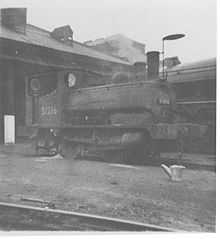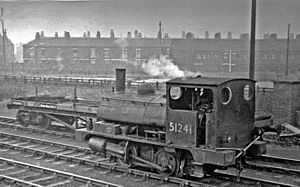L&YR Class 21
| L&YR Class 21 | |
|---|---|
|
L&YR 'Pug' 0-4-0ST at work in Goole Docks 1954 | |
| Type and origin | |
| Power type | Steam |
| Builder | Lancashire and Yorkshire Railway |
| Build date | 1886, (3) 1891–1910 (57) |
| Total produced | 60 |
| Specifications | |
| Configuration | 0-4-0ST |
| Gauge | 4 ft 8 1⁄2 in (1,435 mm) |
| Driver diameter | 3 ft 0 in (0.914 m) |
| Locomotive weight | 21.25 long tons (21.59 t) |
| Fuel type | Coal |
| Boiler pressure |
1886 built: 140 psi (0.97 MPa); Remainder: 160 psi (1.10 MPa) |
| Cylinders | Two, outside |
| Cylinder size | 13 in × 18 in (330 mm × 457 mm) |
| Performance figures | |
| Tractive effort | 10,060–11,492 lbf (44.7–51.1 kN) |
| Career | |
| Operator(s) | L&YR, LMS, BR |
| Class | L&YR: 21 |
| Power class | LMS: 0F |
| Number in class |
1 January 1923: 58; 1 January 1948: 23 |
| Number(s) | LMS: 11200–11257 |
| Retired | 1912–1963 |
| Disposition | Two preserved, remainder scrapped |
The L&YR Class 21 is a class of small 0-4-0ST steam locomotive built by the Lancashire and Yorkshire Railway for shunting duties. They were nicknamed Pugs.
Operational history

The London, Midland and Scottish Railway (LMS) gave the locomotives the power classification 0F. In total fifty seven were made between 1891 and 1910. They were built for use in sharply curved sidings for shunting duties. The Pugs were allocated by the L&YR for operation in the industrial areas and docks of Fleetwood, Goole, Liverpool and Salford. In later times they became more widely dispersed, reaching places such as Bristol, Bangor, Crewe, Derby, Widnes, York and Swansea. When the LMS was merged into British Railways on 1 January 1948, 23 'Pugs' remained in service. The last was withdrawn in 1964.
Accidents and incidents
- On 5 July 1963, one of the driving wheels of locomotive No. 51232 sheared off at Salford, Lancashire.[1]37
Preservation
Two "Pugs" have survived into preservation, both through the Lancashire and Yorkshire Railway Trust.[2] L&YR No. 19 (LMS No. 11243), built in 1910, was sold by the LMS into industry in 1931 and was acquired by the Trust from the United Glass Bottle Manufacturers Ltd. at Charlton in 1967. It was found to be in poor mechanical condition and was later placed on static display pending overhaul, most recently at the Ribble Steam Railway. L&YR No. 68 (LMS No. 11218, BR No. 51218), built in 1901, was purchased directly from British Rail in 1964 and moved to the Keighley and Worth Valley Railway in January 1965. The locomotive was re-tubed in 1974 and took part in the Stockton & Darlington Railway cavalcade that year. The locomotive was overhauled again in 1997 and continued in service, albeit mostly as a shunting locomotive due to its low power, until its boiler was condemned in 2006. The locomotive, which has carried its original identity of L&YR 68 since 2004, is now in storage at Haworth on the K&WVR pending overhaul following completion of 0-6-0ST No. 752.[3]
Models
Several models of the 'Pug' have been produced commercially. The first was a 'OO'-scale polystyrene kit made in the 1960s by Kitmaster, the moulds for which were subsequently sold to Airfix then passed on to Dapol, which still manufactures the former Airfix plastic kit range. A ready-to-run OO model was produced initially by Airfix then Dapol and finally Hornby where the Pug was produced until 2000. The Pug was reintroduced to Hornby's range in 2010 (R2927) in early British Railways Livery. Larger scale models are available from a number of suppliers including Tower Models of Blackpool.
See also
References
- Casserley, H.C. & Johnston, Stuart W. (1974) [1966]. Locomotives at the Grouping 3: London, Midland and Scottish Railway. Shepperton, Surrey: Ian Allan. pp. 111–112. ISBN 0-7110-0554-0.
- ↑ Earnshaw, Alan (1993). Trains in Trouble: Vol. 8. Penryn: Atlantic Books. ISBN 0-906899-52-4.
- ↑ http://www.lyrtrust.org.uk
- ↑ http://www.lyrtrust.org.uk/
External links
| Wikimedia Commons has media related to L&YR Class 21. |
| ||||||||||||||||||||||||||||||
